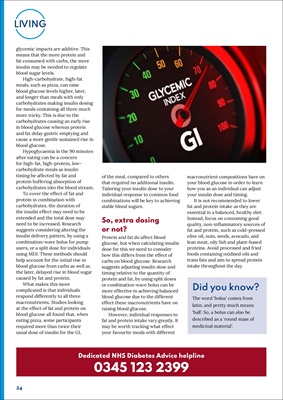
24
LIVING
glycemic impacts are additive. This
means that the more protein and
fat consumed with carbs, the more
insulin may be needed to regulate
blood sugar levels.
High-carbohydrate, high-fat
meals, such as pizza, can raise
blood glucose levels higher, later,
and longer than meals with only
carbohydrates making insulin dosing
for meals containing all three much
more tricky. This is due to the
carbohydrates causing an early rise
in blood glucose whereas protein
and fat delay gastric emptying and
cause a more gentle sustained rise in
blood glucose.
Hypoglycaemia in the 90 minutes
after eating can be a concern
for high-fat, high-protein, lowcarbohydrate
meals as insulin
timing be affected by fat and
protein buffering absorption of
carbohydrates into the blood stream.
To cover the effect of fat and
protein in combination with
carbohydrates, the duration of
the insulin effect may need to be
extended and the total dose may
need to be increased. Research
suggests considering altering the
insulin delivery pattern, by using a
combination-wave bolus for pump
users, or a split dose for individuals
using MDI. These methods should
help account for the initial rise in
blood glucose from carbs as well as
the later, delayed rise in blood sugar
caused by fat and protein.
What makes this more
complicated is that individuals
respond differently to all three
macronutrients. Studies looking
at the effect of fat and protein on
blood glucose all found that, when
eating pizza, some participants
required more than twice their
usual dose of insulin for the GL
of the meal, compared to others
that required no additional insulin.
Tailoring your insulin dose to your
individual response to common food
combinations will be key to achieving
stable blood sugars.
So, extra dosing
or not?
Protein and fat do affect blood
glucose, but when calculating insulin
dose for this we need to consider
how this differs from the effect of
carbs on blood glucose. Research
suggests adjusting insulin dose and
timing relative to the quantity of
protein and fat, by using split doses
or combination-wave bolus can be
more effective in achieving balanced
blood glucose due to the different
effect these macronutrients have on
raising blood glucose.
However, individual responses to
fat and protein intake vary greatly. It
may be worth tracking what effect
your favourite meals with different
macronutrient compositions have on
your blood glucose in order to learn
how you as an individual can adjust
your insulin dose and timing.
It is not recommended to lower
fat and protein intake as they are
essential in a balanced, healthy diet.
Instead, focus on consuming good
quality, non-inflammatory sources of
fat and protein, such as cold-pressed
olive oil, nuts, seeds, avocado, and
lean meat, oily fish and plant-based
proteins. Avoid processed and fried
foods containing oxidised oils and
trans fats and aim to spread protein
intake throughout the day.
Dedicated NHS Diabetes Advice helpline
0345 123 2399 Did you know?
The word 'bolus' comes from
latin, and pretty much means
'ball'. So, a bolus can also be
described as a 'round mass of
medicinal material'.